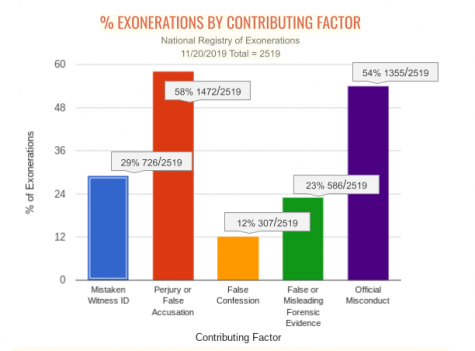Death Penalty Continues to Take Innocent Lives
Exploring the dangerous consequences of America’s continued use of capital punishment
November 21, 2019
Just this last Wednesday, November 13, 2019, Ray Jefferson Cromartie closed his eyes for the last time. Supposedly, in 1994, he shot and killed Richard Slysz who was working in a convenience store Cromartie and his partner tried to rob. At least, that’s what the general population thought until the driver of their getaway vehicle declared at the last minute that he had overheard the other man say that he shot Slysz. On top of this, Cromartie and the Slysz’s daughter, Elizabeth Legette, had requested DNA testing on the gun used to kill Slysz in order to prove Cromartie’s innocence, but were denied by the state of Georgia.[1]
Multiple factors led to this man’s wrongful execution. But how often are instances like this occurring? Surely, if the process to convict and sentence someone to death takes roughly 14 to 19 years[2], then there is little room for error.
One can split up the phases of a trial into eight sections (although not every state follows this exact procedure, they’re relatively similar across the board). Pre-Trial, Guilt Phase Trial, Penalty Phase Trial, Direct Appeal, Post-Conviction Review, Federal Habeas Corpus, Clemency, and Execution.[3]
On the surface, this seems like a nearly foolproof method to catch some of America’s darkest minds. A study from Michigan State University College of Law and the University of Pennsylvania School of Medicine found that between 1973 and 2004, the percentage of wrongful executions was at least 4.1%.[4]
While it is nearly impossible to prove that someone was innocent after they have been executed, the data was based on exonerations in which the defendant was on death row (the defendant was in line for execution, but was proven to be innocent before it came).[4]
If the government is murdering at least one innocent person through the death penalty, then it isn’t doing its job.
The list of victims can go on and on. So why are innocent people consistently being convicted and murdered as the death penalty continues? A deeper look into such cases shows misconduct and perjury are the two greatest causes.[5]
The definition of misconduct is a bit vague, but to put it in simple terms, it is when officials take advantage of their power to distort a case. The most common form of it in the death penalty is with ”police or prosecutors (or both) concealing exculpatory evidence” according to the National Registry for Exonerations.[5]
Regrettably, it is nearly impossible to prove that someone is guilty for certain without a recorded tape. TV shows like “Criminal Minds” or “CSI” would have you believe that DNA testing is foolproof. So maybe that’s the solution.
Despite these dramatizations, DNA testing is not as reliable as the public has come to believe. Errors can easily occur in the lab, but since the process is viewed as nearly perfect, a jury can be misled by a false match. [7]
Unfortunately, America is not going to agree to ban the entire death penalty anytime soon. It makes sense. Capital punishment, if used in a perfect world, can ensure public safety. No matter what precautions are taken in issuing the death penalty, there is always the risk of a false conviction and the death of innocent life. America should not stand for its government having the ability to kill people, especially because there is always the possibility of wrongful execution.
Nevertheless, steps can be made towards progress so that it is not an entirely inhumane process. Currently, the most common drug for executions is pentobarbital, the newest form following the three-drug method (anesthetic, paralyzer, lethal injection).[8] The issue comes from its lack of supply.
Lundbeck, the drug company that used to sell pentobarbital to the US hasn’t for years. That hasn’t stopped states from creating their version of it in pharmacies. However, creating drugs is a risky business, and has already led to botched executions when it wasn’t made in the right way.[8]
As for the states that still use the three-drug method, the lethal injection (potassium chloride) is a very painful drug if not sedated correctly. The most common anesthetic, sodium thiopental, has a short period/ That means that prisoners could be dying an extremely painful death, but an observer would be none the wiser due to the paralyzer.[8]

At the very least, alternatives can be implemented to avoid the horror stories of botched executions that can be found all across the internet. Nitrogen hypoxia is one such solution, a painless method due to the human body’s inability to sense an excess of nitrogen. Death occurs in minutes and feels simply like falling asleep.[9]
This method, while painless, does not solve the issue of wrongful convictions. That can never be solved through policy changes. Until there are groundbreaking scientific discoveries in the DNA testing field or 1984-style surveillance, one can never know of someone’s guilt for sure.
Innocent lives should not be lost just to kill some murderers who were already in jail. America needs the eradication of the death penalty because the ends do not justify the means.
Sources
[1] Miller, Ryan W. “Georgia Inmate Executed for 1994 Convenience Store Killing as Last-Minute DNA Test Denied.” USA Today, 14 Nov. 2019, https://www.usatoday.com/story/news/nation/2019/11/14/ray-jefferson-cromartie-killed-1994-killing-after-dna-test-denied/4188906002/www.npr.org/2019/07/26/745722219/lethal-injection-drugs-efficacy-and-availability-for-federal-executions.
[2] Snell, Tracy L. Capital Punishment, 2017: Selected Findings . Bureau of Justice Statistics, 2019, www.bjs.gov/content/pub/pdf/cp17sf.pdf.
[3] “Stages in a Capital Case.” Death Penalty Curricula for High School, Michigan State University Comm Tech Lab and Death Penalty Information Center, 1 Nov 2001, https://deathpenaltycurriculum.org/student/c/about/stages/stages.PDF.
[4] Gross, S. R., et al. “Rate of False Conviction of Criminal Defendants Who Are Sentenced to Death.” Proceedings of the National Academy of Sciences, vol. 111, no. 20, 20 Mar. 2014, pp. 7230–7235., doi:10.1073/pnas.1306417111.
[5] “Exonerations In 2017.” The National Registry of Exonerations, 14 Mar. 2018, pp. 1–22., www.law.umich.edu/special/exoneration/Documents/ExonerationsIn2017.pdf.
[6] “% Exonerations by Contributing Factor.” The National Registry of Exonerations, 20 Nov. 2019, www.law.umich.edu/special/exoneration/Pages/ExonerationsContribFactorsByCrime.aspx.
[7] Philips, Christopher, et al. “Making Sense of Forensic Genetics.” European Forensic Genetics Network of Excellence, 2017, pp. 1–39., senseaboutscience.org/wp-content/uploads/2017/01/making-sense-of-forensic-genetics.pdf.
[8] Neilson, Susie. “Lethal Injection Drugs’ Efficacy And Availability For Federal Executions.” NPR, 26 July 2019, www.npr.org/2019/07/26/745722219/lethal-injection-drugs-efficacy-and-availability-for-federal-executions.
[9] Brierley, J B. “Experimental Hypoxic Brain Damage.” Journal of Clinical Pathology, vol. s3-11, no. 1, 1977, pp. 181–187., doi:10.1136/jcp.s3-11.1.181.






































